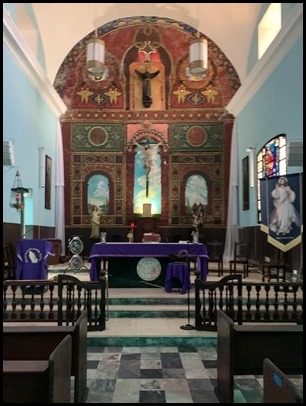Hello and welcome!
Last year, because so many Lenten activities were cancelled, we prepared a one-week Virtual Lenten Retreat, and we are planning to do the same this year. It will be presented on Monday through Friday before Holy Week, and it will be presented on CatholicTV, as well as online. So, late last week, we began work on it at the cathedral with Bishop Bob Reed and the team from CatholicTV.
Saturday, I went to visit the Waters family of Weymouth whose son, Quinn, is battling brain cancer. Quinn had recently done his First Communion, so I came to bring him Communion accompanied by Mother Olga of the Daughters of Mary of Nazareth.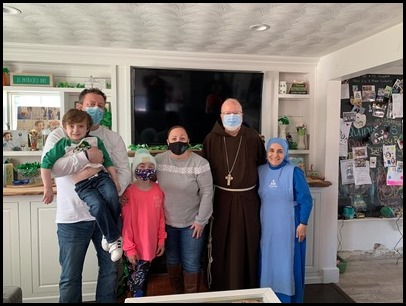
We had a lovely visit with his family — his parents Tara and Jarlath, his sister Maggie and his grandmother. We prayed together, and then Quinn received his Communion.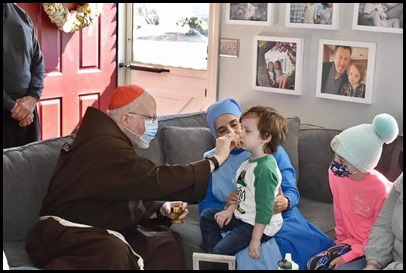
I told Quinn’s father that I have not met many Jarlaths, but that was almost the name given to me when I joined the Capuchins. I didn’t know until last minute that, when you receive the habit, the superior would say, “From now on you will be Friar …” and assign you a name. Your heart would skip a beat because you never knew what he was going to say. My fear was that they would give me some German name that my family would be very unhappy with. (Imagine if their son Patrick suddenly became Wolfgang, Lugwig or something like that!) So, I asked the novice master to please give me an Irish name, and his ideas were Finbarr, Jarlath or Seán. Obviously, we know what he decided on!
After our visit, they were showing off their Irish flags that they already have up for St. Patrick’s Day.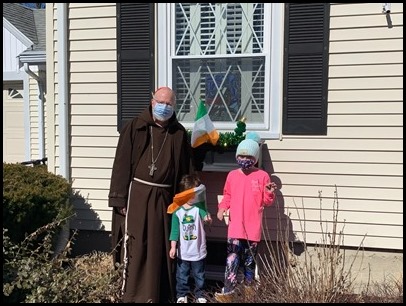
As many may know, Mother Olga is originally from Iraq. So, while I was with her, we had a chance to speak a bit about how important and historic the Holy Father’s visit to that country was.
I told her how fascinated I was to see that the Iraqis brought out bagpipes to meet the Holy Father. They must have known that St. Patrick’s Day is approaching, too!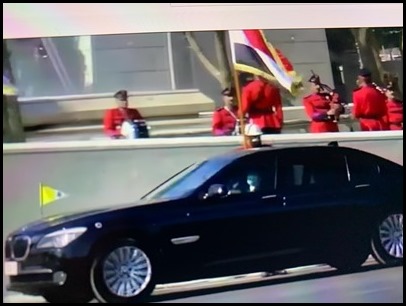
Sunday, I travelled to Puerto Rico to celebrate the ordination of one of our Capuchin friars, Father Gamalier Martínez. It was a great joy to celebrate the ordination of another friar of our Custody of Puerto Rico, which is part of my province.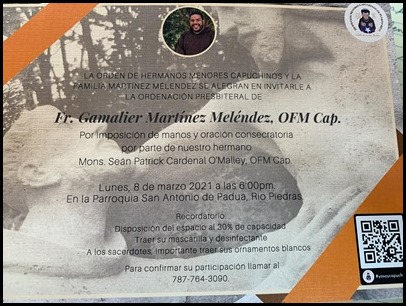
I originally thought I was going to have to undergo a quarantine and comply with different travel restrictions if I made the trip. But I was very pleased when, about two weeks ago, Gov. Baker announced there were three places the United States that were considered “low risk” — Hawaii, North Dakota and Puerto Rico.
I arrived Sunday evening and stayed at the Church of San Francisco in Old San Juan, a church that our friars have maintained for over 400 years. A few blocks away is the Cathedral Basilica of St. John the Baptist, where Ponce de Leon is buried.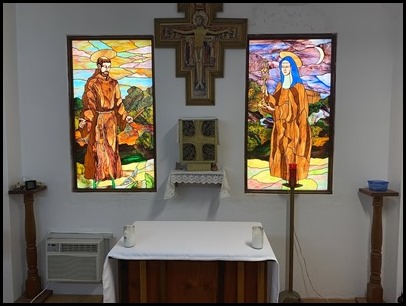
The main Church of San Francisco
On Monday afternoon I was able to have lunch with Archbishop Roberto Gonzales who, of course, has many Boston connections and whom I’ve known since he was a seminarian. It was wonderful to see him again.
That evening was the ordination of Brother Gamalier at the Church of San Antonio de Padua in Río Piedras, the parish where I was sent as a subdeacon many years ago. Because of capacity restrictions, there was a small group of people present with us in person, including his family, some of the friars and a number of the priests he had studied with, as well as our provincial, Father Tom Betz from Pittsburgh. 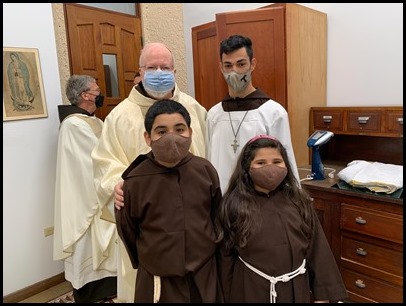
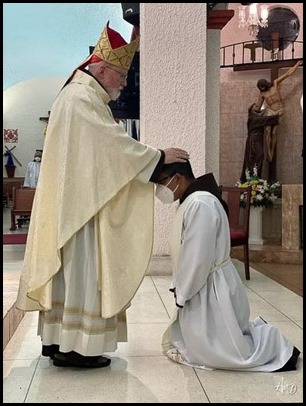
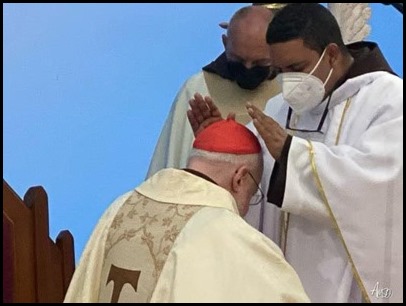
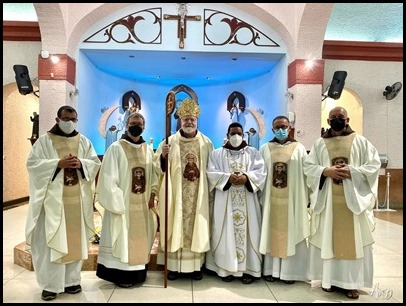 In the church, I took note of this picture of Blessed Carlos Manuel Rodríguez, who is the first blessed (and hopefully soon to be saint) from Puerto Rico.
In the church, I took note of this picture of Blessed Carlos Manuel Rodríguez, who is the first blessed (and hopefully soon to be saint) from Puerto Rico.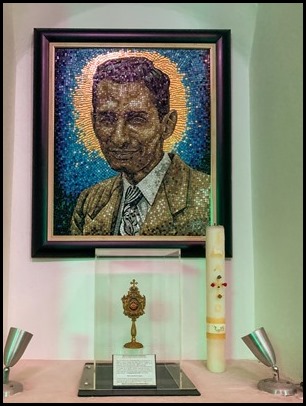
He was an extraordinary layman who was very devoted to the liturgy, particularly the celebration of Easter vigil. In fact, a great deal of the work that he did with university students took place at that parish.
Recently, I wrote a prologue for a book on Blessed Carlos Manuel, “Una Mistica Pascual,” that I would like to share with you here:
From my days in the seminary, the Acts of the Apostles has always been one of my favorite parts of the New Testament. I am always moved by St. Luke’s description of that first parish, where those early Christians were united assiduously in the teaching of the apostles, in prayer, in fellowship and the breaking of the bread. No one was in need because they shared their belongings and felt called to care for widows and orphans and to welcome strangers. They were human beings and, like all of us, struggled to live their faith, but the astounding energy, courage in the face of persecution and deep sense of community was born of their profound awareness of the resurrection and the presence of the risen Lord in their midst.
I was honored to be invited to write this introduction for an extraordinary study of the liturgical Paschal spirituality of a man who, like those first Christians in the Acts of the Apostles, lived intensely each day the transformation rendered by the presence of the risen Lord.
My own experience of the deep faith and religiosity of the Puerto Rican people began when I was sent as a subdeacon to work in the parish San Miguel in the town of Utuado in 1968. In those days, the journey from San Juan to Utuado was an all-day affair. It was a harrowing ride of hairpin turns on the mountain roads.
The town surrounded by magnificent mountains and coffee fincas has a beautiful colonial church, three centuries old, which faces the central plaza in the classical style of the colonial Puerto Rican towns.
The means of transportation were basically jeeps and horses. Padre Pablo Brodie and myself would go by horseback to the chapel in Tetuan Arriba. The jíbaro children would call out in greeting: “Bendición, Fray.” The popular religiosity expressed itself richly in the processions, rosaries and novenas. Many women wore the habit indicating their “promesa” to the Virgin or one of the saints.
Later on, as a priest, I came to know the rich Puerto Rican tradition of the Christmas season with the misas de Aguinaldo and the extraordinary repertoire of villancicos, and the celebration of Reyes. Likewise, the Lenten practices culminating with the monumentos of Holy Thursday, the living stations of the cross on Good Friday and the procession of the Encuentro, which depicts the one of the mysteries of the Franciscan crown rosary that evokes the meeting of the risen Lord with his mother on Easter.
Being aware of the persecution of the church and expulsion of Spanish clergy after the Spanish-American war, the faith in great part was saved because of the lay preachers, los Hermanos Cheos. Their courage in teaching the Catholic faith, practices of piety and popular religiosity clearly demonstrate the crucial role of the laity in the life of the church of Puerto Rico.
Blessed Carlos Manuel is in that same tradition of the Puerto Rican laity truly living as missionary disciples and witnessing to the faith by the coherence of their life and apostolate. He brings to this rich tradition of popular religiosity his keen theological insights into the liturgy and the mysteries of faith that make a remarkable contribution to the life of the church.
I grew up in a world where the highlight of Holy Week was Good Friday with a three-hour celebration of the reading of the Passion, the preaching on the seven last words and the Mass of the pre-sanctified.
As an altar boy, I would serve at the Holy Saturday liturgy that was held early on Saturday morning and attended by handful of people. The most important feature of Holy Saturday was the ringing of the church bells at noon that indicated the end of the Lenten fast.
It is amazing how the Easter Vigil has evolved in the life of our church thanks to prophets like Blessed Charlie, who proclaimed the beauty and centrality of this liturgy, the most important ecclesial event of the year. It has allowed us to see Lent as a baptismal retreat and to accompany our new Catholics beginning at the Rite of Election on the first Sunday of Lent that culminates in their baptism on Holy Saturday and the call to renew our own baptismal promises as we celebrate the mother of all vigils.
Father José Gabriel Corazon Lopez, in his study of the liturgical Paschal spirituality of Blessed Carlos Manuel Rodriguez Santiago, “Una Mistica Pascual,” has given us a very important theological reflection in the beautiful insights of the “kniede Theologie,” the theology on the knees, of our first Puerto Rican blessed. In our recent history, we have been blessed by the extraordinary theological reflections on Holy Saturday, by theologians like Von Baltazar and Pope Benedict. Here we discover the faith life of a Catholic layman who is on fire with his love for the risen Lord and for whom the liturgy is a Tabor experience.
For Blessed Carlos Manuel the aim of all spirituality is our transformation and configuration in Christ. The resurrection is the high point of the life of Christ in the history of salvation and in the life of every Christian. Blessed Carlos Manuel once said: “La Noche Pascual podría llegar a ser la experiencia religiosa cumbre tanto para el clero como para los fieles; si tanto los unos como los otros la comprendieran, apreciaran y celebraran debidamente.”
In a world so addicted to entertainment, many people arrive at church looking for an experience of being entertained or stimulated by an engaging sermon and a robust musical program. This individualistic approach to liturgy is very deficient and often leads to people abandoning church attendance when the preaching and music are deficient. When Flannery O’Connor as a young girl invited a little Baptist girl to accompany her to Mass she could not wait to get the little girl’s reaction. As soon as the Mass was over, she asked her: “What do you think? Did you like it?” The little girl responded: “You Catholics really have something. The music was so bad. The preaching was so boring, and the priest mumbled in a language nobody could understand. And all those people were there!” This does not gainsay the importance of good preaching and beautiful music. Pope Francis often speaks about the via pulchritudinis as an important way of evangelizing. However, the sad reality is that many people have only a very superficial understanding of the liturgy. In Blessed Carlos Manuel, we have a layman who discovered that the liturgy truly is the source and summit of the life of our church. His love for the liturgy that transformed him and brought him joy motivated him to seek to share that knowledge and understanding with young people. His witness should be an inspiration to us today to help our young people to discover the powerful and loving presence of the risen Lord in our celebration of the Eucharist and especially in the Easter Vigil which has pride of place in our liturgical year.
We are profoundly grateful to Father Corazon Lopez for this timely and thorough study of the spirituality of Blessed Charlie. Hopefully, as more of our young Catholics become acquainted with the life and works of this Puerto Rican saint, it will help them to experience the presence of the risen Lord in their own lives and come to love the liturgy as he did.
Pope Benedict, in 2005, spoke of the 49 Christians who were taken by surprise celebrating the Eucharist gathered in the house of Octavius Felix, thereby defying the imperial prohibitions. They were arrested and taken to Carthage. A certain Emeritus was asked by the proconsul why they disobeyed the Emperor’s orders; he replied. “sine Domenico non possumus”, in other words we cannot live without Sunday, without Easter, without the Eucharist. The witness of these early martyrs is the same faith that inspired Blessed Carlos Manuel to witness to all of us that without the sacraments of the risen Lord we cannot live, we cannot find meaning. It is the light of the risen Christ shining in the darkness that ultimately brings us joy and salvation.
The Latin question “Quem queritis?” from the medieval Easter liturgy gave rise to a large body of medieval liturgical drama in which the Angels at Christ’s tomb asked the three Marys, “Whom do you seek?” Today we find the answer to that question eloquently proclaimed in the “mística pascual” of an Easter saint who encountered the risen Lord and who tirelessly sought to share that joy with his brothers and sisters.
I returned to Boston on Tuesday and, that evening, I was happy to join the Order of Malta for a virtual gathering focused on formation activities at St. John’s Seminary. 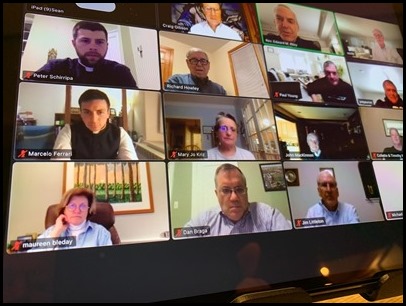
During the Zoom meeting, Father Ed Riley and seminarians Marcel Ferrari and Peter Schirripa spoke about the formation programs at the seminary.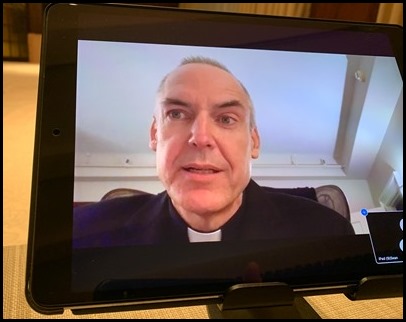
Wednesday, I happened to be going by the Prudential Center and decided to stop in at St. Francis Chapel, where I was able to greet the Oblates and say a prayer.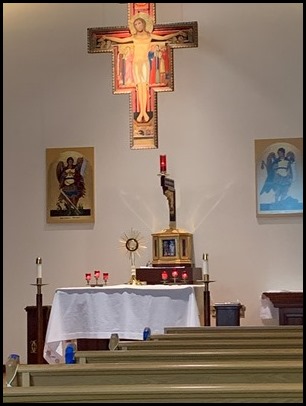
Finally, I was very grateful that, this week, the Salesian Fathers sent me a booklet they have prepared on the life and ministry of Bishop Emilio Allué.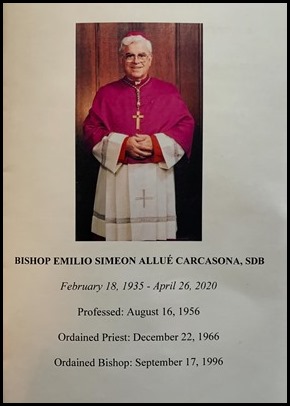
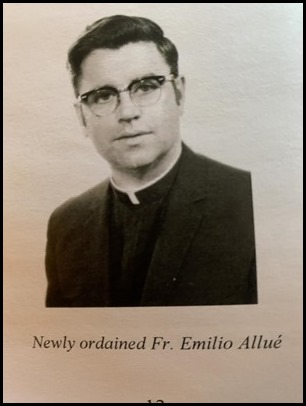
Since the anniversary of his death is approaching, I thought I would remind everyone to pray for him and for all of our loved ones who have died during this pandemic.
Until next week,
Cardinal Seán

